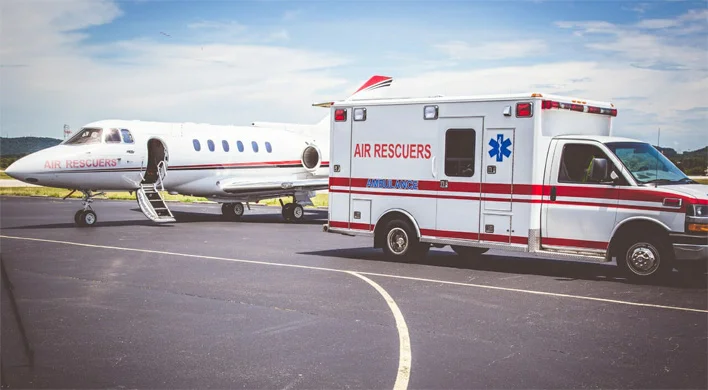A Paramount Supporter During Medical Emergencies – Air Rescuers
In the delicate balance between life and unexpected events, having a quick and effective medical response is crucial. In those critical moments where time is everything, air ambulances have become a real game-changer in emergency medical services.
As we navigate the complexities of healthcare, it’s clear that being able to reach people fast is incredibly important, especially in life-threatening situations. The air ambulance, with its ability to go anywhere quickly and bring medical help to those in need, has become a vital supporter during medical emergencies.
This blog delves into the important role of air ambulances, exploring why they matter, what they can do, and the positive impact they have on emergency healthcare. Come with us on a journey through the skies, where each flight is a lifeline, and every moment is a chance to make a big difference in someone’s life.
Evolution of Air Ambulance Services
The evolution of air ambulance services is a fascinating journey that traces the development of aerial medical transport from its early stages to the sophisticated and crucial service it is today.
- Early History
Pioneering Days: The concept of using aircraft for medical evacuation began during times of conflict, particularly in World War I and II. This marked the initial recognition of the potential of air transport in providing swift medical assistance to the wounded. - Transition to Civilian Use
Post-War Developments: After the wars, the knowledge gained in military medical evacuation was applied to civilian emergencies. This transition laid the foundation for the use of air ambulances in non-military settings.
Emergence of Helicopter Ambulances: Helicopters emerged as a game-changer, offering the ability to access remote or difficult terrain quickly. This innovation significantly improved response times. - Technological Advancements
Advanced Life Support Systems: The integration of advanced life support systems on aircraft became a pivotal advancement. This allowed for critical medical interventions during transit.
>Telemedicine Integration: The incorporation of telemedicine technology further enhanced the capabilities of air ambulances, enabling real-time communication with medical experts on the ground. - Specialized Aircraft and Equipment
Helicopters vs. Fixed-Wing Aircraft: Different types of aircraft were introduced, each serving specific needs. Helicopters proved valuable for short-distance, on-the-spot rescues, while fixed-wing aircraft facilitated long-distance transfers.
Medical Equipment: The on-board medical equipment evolved to include state-of-the-art tools, ensuring comprehensive care during transit. - Enhanced Training for Medical Personnel
Evolution of Paramedic Training: The training of medical personnel involved in air ambulance services evolved to meet the unique challenges of providing care in a dynamic and confined space.
Collaboration with Specialized Teams: Collaboration with specialized medical teams became crucial to handle diverse and complex medical situations. - Global Expansion
Accessibility in Remote Areas: Air ambulances played a pivotal role in addressing the challenges of reaching remote or inaccessible areas, contributing to global healthcare accessibility.
Cross-border Collaborations: International collaborations and partnerships expanded the reach of air ambulance services, ensuring a coordinated response to emergencies. - Integration with Emergency Services
Coordination with Ground Ambulances: Seamless coordination with ground ambulance units became essential for the smooth transfer of patients from air to ground and vice versa. - Challenges and Innovations
Overcoming Weather Challenges: Innovations in navigation and aircraft technology addressed challenges posed by adverse weather conditions.
Future Technological Innovations: Ongoing advancements in technology promise further improvements in the speed, safety, and efficiency of air ambulance services. - Impact on Patient Outcomes
Time-Sensitive Interventions: The swift response of air ambulances proved critical in delivering time-sensitive medical interventions, positively impacting patient outcomes.
>Improved Survival Rates: The ability to rapidly transport patients to advanced medical facilities contributed to improved survival rates and better overall recovery.
(Our India Presence)
AIR AMBULANCE SERVICES IN AGARTALA
AIR AMBULANCE SERVICES IN AGRA
AIR AMBULANCE SERVICES IN AHMEDABAD
AIR AMBULANCE SERVICES IN AIZAWL
AIR AMBULANCE SERVICES IN AKOLA
AIR AMBULANCE SERVICES IN AMRITSAR
AIR AMBULANCE SERVICES IN AMRAVATI
AIR AMBULANCE SERVICES IN ANAND
AIR AMBULANCE SERVICES IN AURANGABAD
AIR AMBULANCE SERVICES IN BENGALURU
AIR AMBULANCE SERVICES IN BAREILLY
AIR AMBULANCE SERVICES IN BELGAUM
AIR AMBULANCE SERVICES IN BHARUCH
AIR AMBULANCE SERVICES IN BIRATNAGAR
AIR AMBULANCE SERVICES IN BHAVNAGAR
AIR AMBULANCE SERVICES IN BHILWARA
AIR AMBULANCE SERVICES IN BHUJ
AIR AMBULANCE SERVICES IN BIHAR
AIR AMBULANCE SERVICES IN BIKANER
AIR AMBULANCE SERVICES IN BILASPUR
AIR AMBULANCE SERVICES IN BIRATNAGAR
AIR AMBULANCE SERVICES IN BOKARO
AIR AMBULANCE SERVICES IN CALICUT
AIR AMBULANCE SERVICES IN CHAMBA
AIR AMBULANCE SERVICES IN CHANDIGARH
AIR AMBULANCE SERVICES IN CHENNAI
AIR AMBULANCE SERVICES IN COIMBATORE
AIR AMBULANCE SERVICES IN CUTTACK
AIR AMBULANCE SERVICES IN DISPUR
AIR AMBULANCE SERVICES IN AMARAVATI
AIR AMBULANCE SERVICES IN UTTAR PRADESH
AIR AMBULANCE SERVICES IN SIKKIM
AIR AMBULANCE SERVICES IN NAGALAND
AIR AMBULANCE SERVICES IN MAHARASHTRA
AIR AMBULANCE IN HIMACHAL PRADESH
AIR AMBULANCE SERVICES IN ASSAM
AIR AMBULANCE SERVICES IN MALDA
AIR AMBULANCE SERVICES IN PURNIA
AIR AMBULANCE SERVICES IN DUMKA
AIR AMBULANCE SERVICES IN ERNAKULAM
AIR AMBULANCE SERVICES IN KOPPAL
AIR AMBULANCE SERVICES IN GUNA
AIR AMBULANCE SERVICES IN DARBHANGA
AIR AMBULANCE SERVICES IN DARJEELING
AIR AMBULANCE SERVICES IN DEHRADUN
AIR AMBULANCE SERVICES IN DELHI
AIR AMBULANCE SERVICES IN DHARAMSHALA
AIR AMBULANCE SERVICES IN DHULE
AIR AMBULANCE SERVICES IN DIBRUGARH
AIR AMBULANCE SERVICES IN DIMAPUR
AIR AMBULANCE SERVICES IN GAGGAL
AIR AMBULANCE SERVICES IN GANDHIDHAM
AIR AMBULANCE SERVICES IN GANDHIGRAM
AIR AMBULANCE SERVICES IN GANDHINAGAR
AIR AMBULANCE SERVICES IN GANGTOK
AIR AMBULANCE SERVICES IN GAYA
AIR AMBULANCE SERVICES IN GOA
AIR AMBULANCE SERVICES IN GORAKHPUR
AIR AMBULANCE SERVICES IN GUWAHATI
AIR AMBULANCE SERVICES IN GWALIOR
AIR AMBULANCE SERVICES IN HARIDWAR
AIR AMBULANCE SERVICES IN HYDERABAD
AIR AMBULANCE SERVICES IN IMPHAL
AIR AMBULANCE SERVICES IN INDORE
AIR AMBULANCE SERVICES IN JAGDALPUR
AIR AMBULANCE SERVICES IN JAIPUR
AIR AMBULANCE SERVICES IN JAISALMER
AIR AMBULANCE SERVICES IN JALANDHAR
AIR AMBULANCE SERVICES IN JALGAON
AIR AMBULANCE SERVICES IN JAMMU
AIR AMBULANCE SERVICES IN JAMNAGAR
AIR AMBULANCE SERVICES IN JHANSI
AIR AMBULANCE SERVICES IN JODHPUR
AIR AMBULANCE SERVICES IN JORHAT
AIR AMBULANCE SERVICES IN KANDLA
AIR AMBULANCE SERVICES IN TRIPURA
AIR AMBULANCE SERVICES IN RAJASTHAN
AIR AMBULANCE SERVICES IN MIZORAM
AIR AMBULANCE SERVICES IN MADHYA PRADESH
AIR AMBULANCE SERVICES IN HARYANA
AIR AMBULANCE SERVICES IN ARUNACHAL PRADESH
AIR AMBULANCE SERVICES IN GOPALGANJ
AIR AMBULANCE SERVICES IN JHARSUGUDA
AIR AMBULANCE SERVICES IN DHANBAD
AIR AMBULANCE SERVICES IN KOLHAPUR
AIR AMBULANCE SERVICES IN UMARIA
AIR AMBULANCE SERVICES IN KANPUR
AIR AMBULANCE SERVICES IN KATIHAR
AIR AMBULANCE SERVICES IN KATNI
AIR AMBULANCE SERVICES IN KOCHIN
AIR AMBULANCE SERVICES IN KOHIMA
AIR AMBULANCE SERVICES IN KOLKATA
AIR AMBULANCE SERVICES IN KOTA
AIR AMBULANCE SERVICES IN KOZHIKODE
AIR AMBULANCE SERVICES IN KULLU
AIR AMBULANCE SERVICES IN KUTCH
AIR AMBULANCE SERVICES IN LADAKH
AIR AMBULANCE SERVICES IN LEH
AIR AMBULANCE SERVICES IN LUCKNOW
AIR AMBULANCE SERVICES IN LUDHIANA
AIR AMBULANCE SERVICES IN MADHUBANI
AIR AMBULANCE SERVICES IN MADURAI
AIR AMBULANCE SERVICES IN MANALI
AIR AMBULANCE SERVICES IN MANGALORE
AIR AMBULANCE SERVICES IN MUMBAI
AIR AMBULANCE SERVICES IN MUZAFFARPUR
AIR AMBULANCE SERVICES IN MYSURU
AIR AMBULANCE SERVICES IN NAINITAL
AIR AMBULANCE SERVICES IN NASHIK
AIR AMBULANCE SERVICES IN NOIDA
AIR AMBULANCE SERVICES IN OOTY
AIR AMBULANCE SERVICES IN PANAJI
AIR AMBULANCE SERVICES IN PANTNAGAR
AIR AMBULANCE SERVICES IN PATNA
AIR AMBULANCE SERVICES IN PATIALA
AIR AMBULANCE SERVICES IN PILIBHIT
AIR AMBULANCE SERVICES IN PORBANDAR
AIR AMBULANCE SERVICES IN WEST BENGAL
AIR AMBULANCE SERVICES IN TELANGANA
AIR AMBULANCE SERVICES IN PUNJAB
AIR AMBULANCE SERVICES IN MEGHALAYA
AIR AMBULANCE SERVICES IN KERALA
AIR AMBULANCE SERVICES IN GUJARAT
AIR AMBULANCE SERVICES IN BARMER
AIR AMBULANCE SERVICES IN SIWAN
AIR AMBULANCE SERVICES IN BARGARH
AIR AMBULANCE SERVICES IN BIDAR
AIR AMBULANCE SERVICES IN CHANDRAPUR
AIR AMBULANCE SERVICES IN SEONI
AIR AMBULANCE SERVICES IN RAIGAD
AIR AMBULANCE SERVICES IN RAIPUR
AIR AMBULANCE SERVICES IN RAJKOT
AIR AMBULANCE SERVICES IN RAJNANDGAON
AIR AMBULANCE SERVICES IN RANCHI
AIR AMBULANCE SERVICES IN RATNAGIRI
AIR AMBULANCE SERVICES IN REWA
AIR AMBULANCE SERVICES IN ROURKELA
AIR AMBULANCE SERVICES IN SAGAR
AIR AMBULANCE SERVICES IN SATARA
AIR AMBULANCE SERVICES IN SATNA
AIR AMBULANCE SERVICES IN SAMBALPUR
AIR AMBULANCE SERVICES IN SHILLONG
AIR AMBULANCE SERVICES IN SHIMLA
AIR AMBULANCE SERVICES IN SILCHAR
AIR AMBULANCE SERVICES IN SITAPUR
AIR AMBULANCE SERVICES IN SOLAPUR
AIR AMBULANCE SERVICES IN SURAT
AIR AMBULANCE SERVICES IN TEZPUR
AIR AMBULANCE SERVICES IN THIRUVANANTHAPURAM
AIR AMBULANCE SERVICES IN TINSUKIA
AIR AMBULANCE SERVICES IN TIRUCHIRAPALLI
AIR AMBULANCE SERVICES IN TRIVANDRUM
AIR AMBULANCE SERVICES IN UDAIPUR
AIR AMBULANCE SERVICES IN UJJAIN
AIR AMBULANCE SERVICES IN VARANASI
AIR AMBULANCE SERVICES IN VADODARA
AIR AMBULANCE SERVICES IN VELLORE
AIR AMBULANCE SERVICES IN VIDISHA
AIR AMBULANCE SERVICES IN VIJAYAWADA
AIR AMBULANCE SERVICES IN VISAKHAPATNAM
AIR AMBULANCE SERVICES IN AMARAVATI
AIR AMBULANCE SERVICES IN UTTARAKHAND
AIR AMBULANCE SERVICES IN TAMIL NADU
AIR AMBULANCE SERVICES IN ODISHA
AIR AMBULANCE SERVICES IN MANIPUR
AIR AMBULANCE SERVICES IN KARNATAKA
AIR AMBULANCE SERVICES IN CHHATTISGARH
AIR AMBULANCE SERVICES IN COOCH BEHAR
AIR AMBULANCE SERVICES IN BHAGALPUR
AIR AMBULANCE SERVICES IN DEOGARH
AIR AMBULANCE SERVICES IN THRISSUR
AIR AMBULANCE SERVICES IN DHARWAD
AIR AMBULANCE SERVICES IN PURI
AIR AMBULANCE SERVICES IN DATIA
AIR AMBULANCE SERVICES IN AYODHYA
AIR AMBULANCE SERVICES IN KESHOD
Contact us for more details 24*7 we are here to help you call now:+91 9870001118


